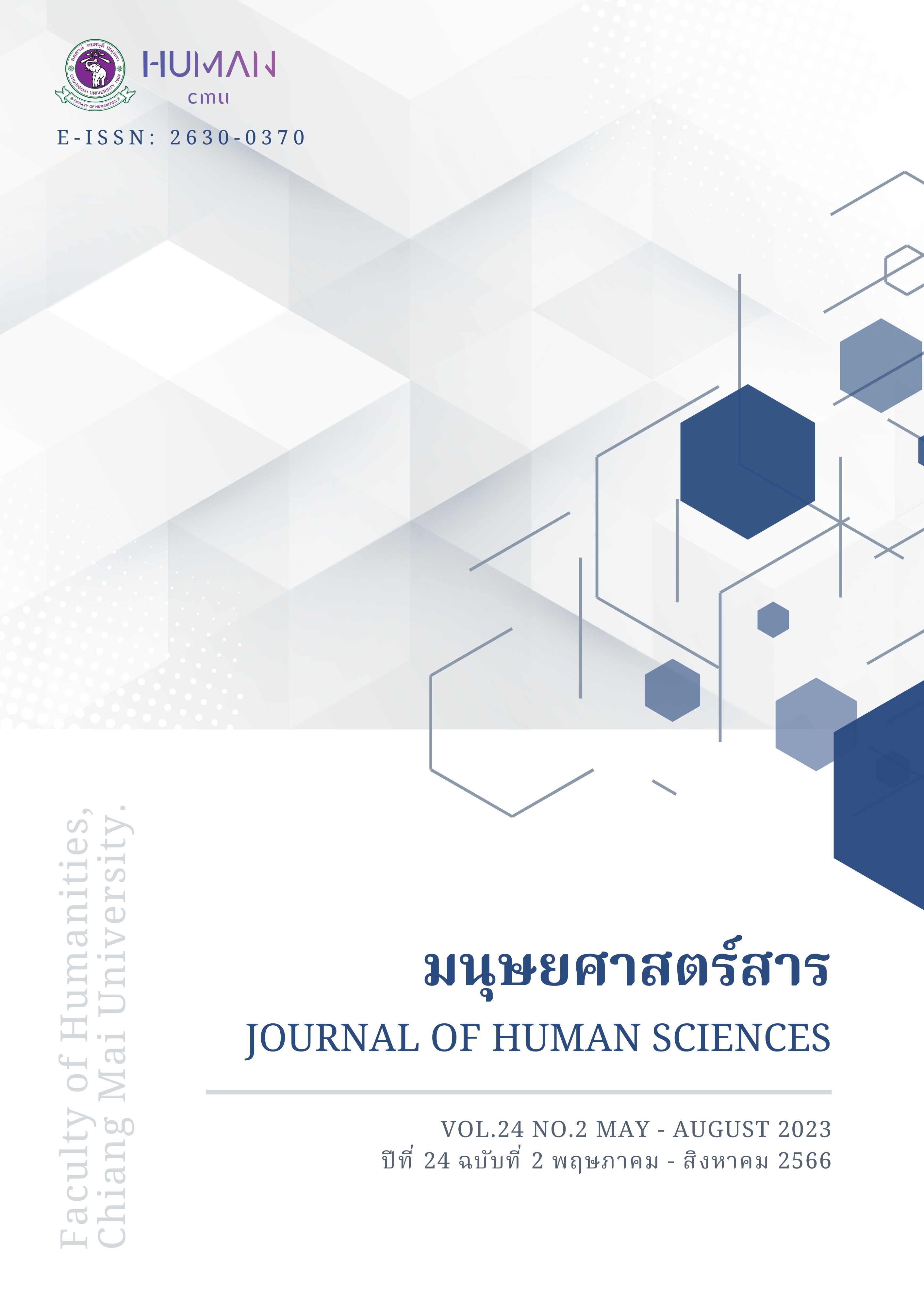ภาวะสมัยใหม่แบบเมือง ความนิยมเรื่องเล่าเร้าอารมณ์ และภาพยนตร์ไทยยุคแรกเริ่ม
Main Article Content
บทคัดย่อ
ชาวสยามเริ่มสร้างภาพยนตร์อย่างจริงจังราวกลางทศวรรษ 2460 เป็นต้นมา ทั้งภาพยนตร์กลุ่มแรกที่เป็นภาพยนตร์บันทึกเหตุการณ์และภาพยนตร์เล่าเรื่องเรื่องแรกๆ ที่สร้างขึ้นนับแต่ปี 2470 ได้บันทึกประวัติศาสตร์ของการเผชิญหน้ากับภาวะสมัยใหม่ในสังคมสยามไว้อย่างมีนัยสำคัญ บทความนี้จะอธิบายให้เห็นว่าภาพยนตร์ยุคแรกเริ่มของสยามไม่ได้ถือกำเนิดขึ้นอย่างฉาบฉวยหรือเพียงลอกเลียนจากภาพยนตร์ต่างประเทศอื่นๆ ซึ่งเป็นที่นิยม หากแต่เป็นการริเริ่มจากการตกผลึกของภาวะสมัยใหม่ในสยามเอง โดยเฉพาะในมิติของความเป็นเมือง การสัมผัสเทคโนโลยี ความวุ่นวายโกลาหล การเร่งเร้าผัสสะความรู้สึก และการขยายตัวของความนิยมต่อเรื่องเล่าเร้าอารมณ์ ซึ่งล้วนแสดงตนอยู่ในภาพยนตร์เหล่านี้เช่นเดียวกับในการสร้างสรรค์ทางวัฒนธรรมประเภทอื่น เช่น ในปริมณฑลของวรรณกรรม จากช่วงสมัยเดียวกัน
Article Details

อนุญาตภายใต้เงื่อนไข Creative Commons Attribution-NonCommercial-NoDerivatives 4.0 International License.
เอกสารอ้างอิง
ข่าวผู้ร้ายลอบฟัน. (2453, 3 มกราคม). จีนโนสยามวารศัพท์, 6.
จำเริญลักษณ์ ธนะวังน้อย. (2544). ประวัติศาสตร์ภาพยนตร์ไทย ตั้งแต่แรกเริ่มจนสิ้นสมัยสงครามโลกครั้งที่ 2. กรุงเทพฯ: สำนักพิมพ์มหาวิทยาลัยธรรมศาสตร์.
โดม สุขวงศ์. (2539). กำเนิดหนังไทย: “โชคสองชั้น” และ “ไม่คิดเลย”. กรุงเทพฯ: มติชน.
นครินทร์ เมฆไตรรัตน์. (2540). การปฏิวัติสยาม พ.ศ. 2475 (พิมพ์ครั้งที่ 2). กรุงเทพฯ: อมรินทร์วิชาการ.
น่าเวทนา. (2453, 8 ธันวาคม). จีนโนสยามวารศัพท์, 2.
ในกรุงเทพฯ. (2453, 12 ธันวาคม). จีนโนสยามวารศัพท์, 2.
บรรณาธิการ. (2465). น่าของบรรณาธิการ. เสนาศึกษาและแผ่วิทยาศาสตร์, 6(12), 1493-1499.
ภาพยนตร์ไทย. (2469, 29 มกราคม). หนังสือพิมพ์ไทย, 8.
ยิงกันขึ้น. (2453, 24 ธันวาคม). จีนโนสยามวารศัพท์, 4.
ราวกับเรื่องหนังฉาย. (2456, 17 เมษายน). กรุงเทพฯ เดลิเมล์, 2.
วันเดียวรถโดนกันสามราย. (2456, 4 เมษายน). กรุงเทพฯ เดลิเมล์, 2.
สถาปนา เชิงจอหอ. (2564). อาชญนิยายไทยและการถ่ายทอดอุดมการณ์ทางการเมืองในประเทศไทยในทศวรรษ 2430-2500 (วิทยานิพนธ์ศิลปศาสตรมหาบัณฑิต, มหาวิทยาลัยนเรศวร).
สมัยที่ต้องรีบเร่ง. (2453, 2 ธันวาคม). จีนโนสยามวารศัพท์, 2.
สุพรรณี วราทร. (2519). ประวัติการประพันธ์นวนิยายไทย. กรุงเทพฯ: มูลนิธิโครงการตำราสังคมศาสตร์และมนุษยศาสตร์.
หมายเหตุเบ็ดเตล็ด. (2470, 5 สิงหาคม). ข่าวภาพยนตร์.
หอภาพยนตร์ (องค์การมหาชน). (2469-2471) เลขที่ หภ.(อ)/9. บริษัทถ่ายภาพยนตร์ไทย (รายหลวงสุนทรอัศวราช).
Barmé, S. (2006). Woman, man, Bangkok: Love, sex, and popular culture in Thailand. Chiang Mai: Silkworm Books.
Beaumont, M. & Freeman, M. (Eds.). (2007). The railway and modernity: Time, space, and the machine ensemble. Bern: Peter Lang.
Canjels, R. (2011). Distributing silent film serials: Local practices, changing forms, cultural transformation. New York: Routledge.
Charney, L. & Schwartz, V. R. (Eds.). (1995). Cinema and the invention of modern life. Berkeley and Los Angeles: University of California Press.
Copeland, M. P. (1993). Contested nationalism and the 1932 overthrow of the absolute monarchy in Siam (Doctoral dissertation, Australian National University)
Dahlquist, M. (Ed.). (2013). Exporting perilous Pauline: Pearl White and the serial film craze. Urbana: University of Illinois Press.
Friedberg, A. (1993). Window shopping: Cinema and the postmodern. Berkeley and Los Angeles: University of California Press.
Gunning, T. (1986). The cinema of attraction: Early film, its spectator and the avant-garde. Wide Angle, 8(3&4), 63-70.
Gunning, T. (2004). Systematizing the electric message: Narrative form, gender, and modernity in The Lonedale Operator.” In C. Keil & S. Stamp (Eds.), American cinema’s transitional era: Audiences, institutions, practices (pp. 15-50). Berkeley and Los Angeles: University of California Press.
Hansen, M. (1987). Benjamin, cinema, and experience: The blue flower in the land of technology. New German Critique, 40, 179-224.
Ichiro, K. (2005). Laying the tracks: The Thai economy and its Railways, 1885-1935. Kyoto: Kyoto University Press.
Keil, C. (2001). Early American cinema in transition: Story, style, and filmmaking, 1907-1913. Madison: University of Wisconsin Press.
Kirby, L. (1997). Parallel tracks: The railroad and silent cinema. Durham: Duke University Press.
Lim, S. (2012). Detective fiction, the police and secrecy in early twentieth century Siam. South East Asia Research, 20(10), 83-90.
Limapichart, T. (2009). The emergence of the Siamese public sphere: Colonial modernity, print culture and the practice of criticism (1860s–1910s), South East Asia Research, 17(3), 361-399.
Presner, T. S. (2007). Mobile modernity: Germans, Jews, trains. New York: Columbia University Press.
Schivelbusch, W. (1986). The railway journey: The industrialization of time and space in the 19th century. Berkeley and Los Angeles: University of California Press.
Singer, B. (2001). Melodrama and modernity: Early sensational cinema and its contexts. New York: Columbia University Press.
Smyth, D. (2003). Ban Maha Phai and Phrae Dam: From silent movie to novel?. Journal of the Siam Society, 91, 223-239.
Suwannakij, S. (2013). King and eye: Visual formation and technology of the Siamese monarchy (Doctoral dissertation, University of Copenhagen).
Vella, W. F. (1978). Chaiyo! King Vajiravudh and the development of Thai nationalism. Honolulu: The University Press of Hawaii.


